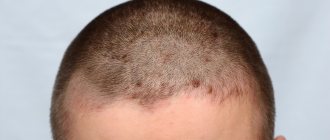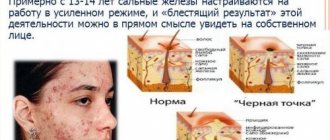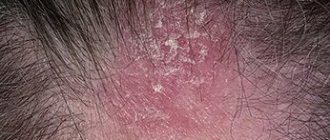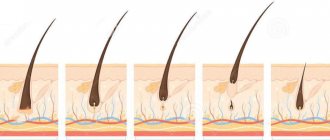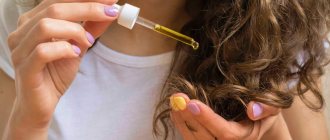- Initial appointment with a trichologist
1800 ₽ - Repeated appointment with a trichologist
1600 ₽
A trichologist is a dermatologist with a narrow specialization who deals with problems of hair and scalp. The diseases this doctor treats can lead to serious cosmetic defects, for example, complete or partial baldness. A timely visit to a specialist will help determine the cause of the problem and begin treatment in a timely manner. It is also worth remembering that problems with hair and scalp can be associated with a lack of nutrients in the body, metabolic disorders or somatic diseases.
At the Miracle Doctor clinic in Moscow, you can make an appointment with a trichologist at a time convenient for you. An experienced doctor with more than 4 years of experience will help determine the cause of the disease, identify associated aggravating factors and develop a treatment program.
The main areas of work of a trichologist
There are a lot of problems associated with hair and scalp, but the most common are the following:
Alopecia. This disease is better known as alopecia. Its main symptom is complete or partial hair loss. In this case, alopecia can appear not only on the head, but also on other parts of the body. In addition to hair loss, the disease prevents the growth of new ones, which leads to serious cosmetic defects.
Genetic predisposition and hormonal imbalances lead to the development of alopecia. Baldness can also begin under the influence of unsatisfactory environmental conditions, after injuries or as a result of taking medications.
Seborrheic dermatitis. This chronic condition is also known as seborrhea. It is characterized by the appearance of red spots and dandruff on the skin, brittle hair and hair loss, and incessant itching. The disease develops as a result of hormonal imbalances, as well as poor heredity. It also appears when the immune system is weakened and under the influence of a fungus. To prescribe optimal therapy, the doctor needs to accurately determine the cause of the disease.
Trichosporia. A fungal disease that is characterized by the appearance on the hair of small nodules of white (on the beard and mustache) or black (on the head) color with an unpleasant odor. Trichosporia is chronic and can be transmitted through household objects. The disease can also develop as a result of using dirty water for washing, damaging the hairy cuticle, or using mineral oils.
Dandruff. According to statistics, this disease affects 15 to 20 percent of people worldwide. Dandruff is white flakes that fall off the scalp. There are many reasons for the development of this syndrome. This could be, for example, a lack of nutrients (amino acids, minerals) in the body, wearing a hat for a long time, improper care of the scalp, neglect of hygiene, and so on. To cure a disease, it is necessary to establish the cause of its occurrence and select appropriate therapy.
Hair growth disorders and associated cosmetic defects. This may be excessive thinness, increased fragility, dull color, tangles, split ends. These disorders may be associated, for example, with improper hair care or somatic diseases, hormonal imbalances, and so on.
Other diseases treated by a trichologist include
- psoriasis;
- ringworm;
- allergic reactions;
- favus;
- pediculosis;
- folliculitis;
- trichoclasia;
- trichoptilosis;
- trichonodosis;
- trichotortosis;
- leukotrichia;
- monilethrix;
- hypertrichosis;
- hirsutism.
Causes of problems
The reasons that can lead to hair problems can be divided into external and internal:
- External – hair dyeing and bleaching, prolonged wearing of tight and uncomfortable hats, tight hairstyles, injuries, improper care, aggressive environmental factors
- Internal - these are various skin diseases, intoxications of the body, infectious diseases, the postoperative period, allergic reactions, hormonal disorders, disorders of the nervous system, deficiency conditions, disruption of the gastrointestinal tract, etc.
Symptoms of hair and scalp diseases
For the most part, they are noticeable both to the patient himself and to the people around him. The most common symptoms include the following hair problems:
- dropping out. A sign of problems is the loss of 80-100 hairs per day;
- thinning;
- slow growth or cessation;
- loss of volume;
- loss of color, dullness;
- fragility;
- split ends;
- increased greasiness;
- early gray hair.
Scalp problems are also reasons to order a consultation with a trichologist:
- itching;
- the appearance of dandruff;
- increased sensitivity.
The difficulty is that each of the listed symptoms can have many causes. The task of a trichologist is to accurately determine the disease and prescribe appropriate therapy.
Causes of hair problems
Their elimination is a prerequisite for treatment. Often, patients attribute unpleasant symptoms to age or poor environment, forgetting that diseases can and should be treated. Remember that hair loss and other hair problems can be eliminated at any age. Their main reasons are
- lack of nutrients in the body: vitamins, micro- and macroelements;
- thyroid diseases;
- hormonal imbalances and disorders;
- anemia;
- metabolic disease;
- severe stress, especially over a long period of time;
- taking medications, especially hormonal ones;
- foci of chronic inflammation in the body;
- improper care of hair and scalp, use of inappropriate products;
- genetic predisposition;
- failure to comply with scalp and hair hygiene requirements;
- parasitic, fungal and viral diseases;
- use of substances and practices that damage hair.
It is worth noting that many of the listed disorders do not manifest themselves until hair problems begin. If they are not eliminated in time, they can lead to the development of other, including more serious diseases.
When should you see a trichologist?
You should make an appointment with your doctor at the first sign of the symptoms mentioned above. Particular attention should be paid to a sharp change in the appearance of the hair (if it has become cloudy, brittle) or its sudden loss (if after a bath or combing you see not just single hairs, but whole strands). It is also worth monitoring your scalp: if dandruff, itching and red spots appear, you should consult a doctor. It is important to understand that restoring hair is much more difficult than treating some diseases at an early stage. The sooner the doctor can prescribe therapy, the higher the chances of a positive outcome.
A timely visit to a trichologist will help not only eliminate existing problems, but also maintain healthy hair for many years. Many procedures can be performed as a preventive measure. This will significantly reduce the risk of developing diseases, including in old age.
Consultation with a trichologist - preparation and diagnosis
A doctor's appointment includes several stages:
- Anamnesis collection. The doctor listens to the patient’s complaints and asks additional questions if necessary. Data on the time and causes of the first symptoms is important. The doctor also examines the patient’s medical history and checks for hair and scalp diseases. Information about what medications and other medications the patient has previously taken is also important.
- Visual inspection.
The doctor pays attention to the presence of dandruff, redness, and other signs of disease. Important! A visual examination by a trichologist is not always limited to hair and the scalp. To obtain information, a specialist often checks the condition of the skin on the elbows, stomach, and neck. The doctor may also check the size of the thyroid gland, nails, mucous membranes, and so on. - Diagnosis of diseases. It may include laboratory tests as well as hardware methods. Thanks to them, the doctor can see structural changes in the hair and scalp, explain to the patient the essence of the problem and justify further treatment tactics. If the doctor has reason to believe that hair problems may be caused by disturbances in the functioning of internal organs, the patient may be prescribed a consultation with doctors of related profiles (endocrinologist, immunologist, allergist, etc.)
- Establishing diagnosis. Once the doctor has all the necessary information, he will be able to accurately determine the disease or diseases that the patient is suffering from. After this, he will be able to develop an individual therapy program.
- Treatment and monitoring of its effectiveness. Therapy may include medications, hardware methods, cosmeceuticals, and injections. In some cases, surgical correction may be required to achieve the desired result.
Diagnosis of hair and scalp diseases
At the Miracle Doctor clinic in Moscow, trichologists use hardware and laboratory diagnostic methods to make a diagnosis. Their combination allows you to get the most complete picture of problems with hair and scalp.
Laboratory diagnostic methods include:
- blood tests - general, biochemical, hormones;
- bacteriological studies;
- spectral analysis of hair. With its help, the doctor can determine mineral deficiency.
Hardware diagnostic methods include:
- trichogram or phototrichogram;
- dermatoscopy.
If necessary, the doctor can also prescribe other tests to assess the condition of the internal organs and systems of the body.
Taking a history of a patient with hair loss
The complaint of “hair loss” may indicate one of two things: an increased amount of hair being lost daily (effluvium) or visible baldness (alopecia). Up to 100 hairs are typically lost daily (3). It is important to ask patients about the medications they are taking. While “hair loss” is listed as a possible side effect in almost all drug labels, only some drugs actually have this as an issue (e1). For example, hair loss after 2-4 months is not uncommon after multiple injections of heparin (e2). Women should be asked about gynecologic factors such as initiating or stopping hormonal contraceptives. Transient postpartum hair loss is normal: labor stress and hormonal changes after childbirth cause many hair follicles to transition from the anagen to telogen phase, and thus hair loss may be noticeable after 2–4 months (2). Highly toxic factors such as chemotherapy drugs can cause severe damage to the follicles, causing hair to break off within the follicle within one to three weeks. As a reassurance, patients can be told that this process synchronizes the growth phases of the follicles so that when the hair grows back, it is often thicker than before. Structural changes may occur in which initially straight hair will re-grow as curly hair, or vice versa (4).
Terminology
Increased daily hair loss is called “effluvium”; visible baldness is called “alopecia.”
Hair and scalp treatment
The therapy program is developed individually for each patient. It is always aimed at
- elimination of symptoms of the disease;
- correction of the reasons that led to its appearance.
The main technologies used for hair restoration are
Mesotherapy. It is effective in treating hair loss. The main task of this method is to compensate for the lack of nutrients: vitamins, minerals, amino acids. A cocktail containing them is injected directly into the scalp.
Plasmolifting. This method stimulates hair growth and stops inflammatory processes. To carry out plasma lifting, a small amount of the patient’s venous blood is taken. The blood plasma is enriched with platelets, and then the composition with it is injected intradermally.
Ozone therapy. This method eliminates hair nutrition problems. It involves the introduction of microinjections of an ozone-oxygen mixture.
Ultrasonic vaporization. The procedure helps correct processes leading to deterioration of hair quality and hair loss. It is also recommended for dandruff and seborrhea. Special medicinal compounds are applied to the area of hair growth. After this, they are exposed to steam.
Cryomassage. This procedure restores impaired blood flow and stimulates hair follicles. Cryomassage involves influencing the skin using low temperatures.
Darsonvalization. This method improves blood supply to the hairy area and tones the blood vessels. The procedure involves local exposure to high frequency current.
Seborrheic dermatitis: what contributes to its development
Seborrhea affects the head and other areas of the body more often if there are accompanying conditions:
- increased skin oiliness;
- life with stress;
- lack of sleep;
- evidence of scalp seborrhea in relatives;
- lymphoma, HIV and other diseases that cause a state of immunosuppression;
- diseases of the nervous system;
- psychical deviations.
Seborrhea develops more often in the presence of these factors, but the reasons for the development of the disease are not completely clear. Seborrheic dermatitis is not a disease of the sebaceous glands, although it develops in areas of the head saturated with them.
A significant role in the development of the disease is played by yeast-like fungi of the genus Malassezia (they inhabit the skin of most healthy people, but in some cases can cause rashes and irritation), the composition of lipids on the skin surface, as well as the characteristics of the immune response to Malazessia fungi and their metabolic products. Regardless of the causes of dermatitis, special measures are required for the scalp. The duration of such treatment can be from two months to six months, and after defeating dermatitis, maintenance therapy is needed for the epidermis of the head, which will prevent the re-development of seborrhea in any part of the body or head.

